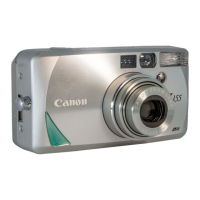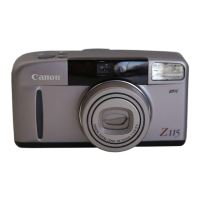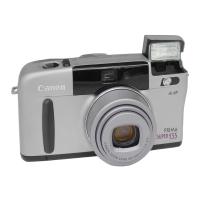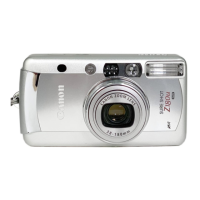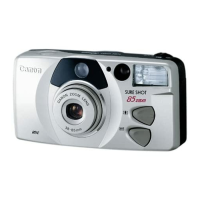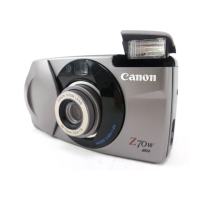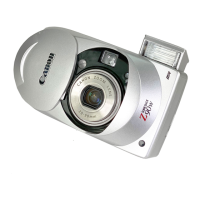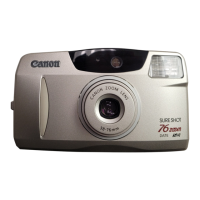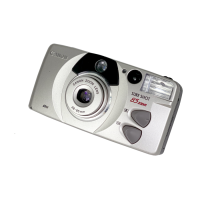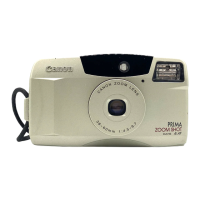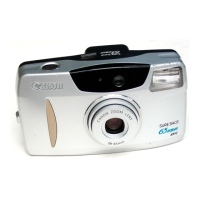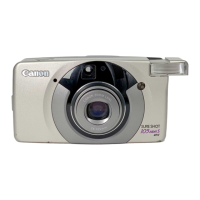
Do you have a question about the Canon Sure Shot Z155 and is the answer not in the manual?
| Brand | Canon |
|---|---|
| Model | Sure Shot Z155 |
| Category | Film Camera |
| Language | English |
Camera is not waterproof; handle with care in wet conditions.
Store camera in a cool, dry, dust-free place away from sunlight.
Warning against self-disassembly due to internal circuitry.
Risks of explosion or burns from battery mishandling.
Use air blower for lens and interior; avoid fluids.
Advice on protecting film from airport X-ray damage.
Timely development for color accuracy.
Symbol indicating extra usage tips.
Symbol indicating shooting advice.
A concise guide to basic camera operations and steps.
Identification of camera parts and controls.
Details about the camera's LCD screen indicators.
Information about the camera's viewfinder and framing.
Instructions on how to attach the camera strap.
Step-by-step guide to inserting batteries.
How to activate the camera using the mode dial.
Method to monitor the battery level via the LCD.
Instructions for inserting film into the camera.
Guide to using the camera's automatic shooting mode.
How to adjust zoom for framing shots.
Tips for capturing images through glass surfaces.
Using a specific mode to minimize operational noise.
Using flash with red-eye reduction for portraits.
Understanding the meaning of viewfinder indicators.
Procedure for taking out the film roll.
Using the dial to select optimal shooting modes.
Mode for capturing fast-moving subjects.
Mode for shooting portraits in low-light or nocturnal settings.
Mode optimized for taking portraits of people.
Mode for capturing detailed shots of nearby subjects.
Mode for shooting subjects in extreme light or dark conditions.
Method to lock focus on subjects not in the center.
Using the self-timer to include yourself in photos.
Adjusting exposure for brighter or darker images.
Options for showing date and time on photos.
Procedure for inputting date and time.
Adding text captions to photographs.
Choosing the language for captions.
Adjusting flash settings and red-eye reduction.
Detailed explanation of the red-eye reduction feature.
Using flash in all conditions or for fill-in.
Disabling flash even in low light.
Using slow shutter speed with flash for background illumination.
Solutions for common camera problems.
Further details on specific camera functions like AiAF.
Detailed explanation of the advanced auto-focus system.
How to configure the camera for spot metering.
Technical details and performance characteristics of the camera.
Step-by-step battery installation process.
Instructions for film insertion.
Powering on the camera by selecting a mode.
Using the zoom lever to frame the shot.
Final step to take a photograph.
Techniques for a stable grip to prevent blur.
Recommended grip using both hands for stability.
Positioning elbows for better camera support.
Proper posture for using the viewfinder.
Preventing hair/fingers from blocking lens/sensors.
How to use the shutter button for focus and capture.
Identifies the auto-focus light emitter.
Locates the shutter release button.
Identifies the control for changing focal length.
Locates the viewfinder eyepiece.
Identifies the light metering sensor area.
Locates the auto-focus light sensor.
Identifies the built-in flash unit.
Locates the lamp for red-eye reduction and self-timer.
Identifies the camera's lens.
Locates the latch for opening the back cover.
Identifies buttons for timer, exposure, flash, rewind, set, select, date, caption.
Locates the window to view film status.
Identifies the main display screen.
Locates the cover for various switches.
Identifies the orange and green indicator lights.
Locates the viewfinder.
Identifies points for attaching the camera strap.
Locates the compartment for batteries.
Identifies the screw for the battery cover.
Locates the dial for selecting shooting modes.
Identifies the mounting point for a tripod.
Detailed breakdown of LCD indicators and their meanings.
Detailed explanation of viewfinder elements and frames.
Step-by-step guide for strap attachment.
Instructions to open the battery compartment.
Correctly inserting batteries with proper polarity.
Securing the battery compartment after insertion.
Initial setup of the camera's date and time.
How to switch on the camera using the mode dial.
Using the LCD indicator to check battery level.
Using DX-coded film for automatic speed setting.
Specific film type recommendation (ISO 400).
Opening the camera's back cover.
Placing the film roll correctly inside the camera.
Advancing the film leader to the correct position.
Securing the back cover after film loading.
Advancing the film to the first frame.
Verifying film readiness via frame counter.
Handling errors if film is not loaded properly.
Specific film type recommendations for slide film.
Activating the camera for shooting.
Adjusting zoom for framing.
Focusing and taking the picture.
Flash behavior in low light conditions.
Using the wide-angle setting for broader shots.
Using the telephoto setting for closer shots.
Preventing lens damage via automatic retraction.
Recommended camera positioning for shooting through glass.
Using a specific mode to minimize operational noise.
Guidance on when to use red-eye reduction.
How to select the red-eye reduction mode.
Optimal distance for red-eye reduction effectiveness.
Ensuring subject cooperation for red-eye reduction.
Taking the picture with the mode active.
Meaning of the green light (focus ready).
Meaning of the orange light (flash charged/shake warning).
Verifying film rewinding completion.
Opening the camera to retrieve the film.
How to rewind film before it's finished.
Initiating mid-roll film rewinding.
Important checks before removing film.
Using the dial to choose shooting settings.
Verifying selected mode on the display.
Explains various mode indicators on the LCD.
Purpose of Action Mode for moving subjects.
How to use the shutter for focus and tracking.
Technique for continuous shooting.
Flash behavior in challenging lighting.
Limitation regarding red-eye reduction.
Indicator behavior in Action Mode.
Purpose of Night Mode for portraits.
How flash and shutter work together.
Red-eye reduction function in Night Mode.
Warning about camera shake in Night Mode.
Advice on keeping subjects still.
Alternative for shooting just night scenes without flash.
Purpose of Portrait Mode for attractive portraits.
Automatic zoom behavior for portraits.
How to frame the subject for focus.
Red-eye reduction in Portrait Mode.
Automatic zoom range for portraits.
Purpose of Close-up Mode for nearby subjects.
Minimum focusing distance.
Limitation on zoom in this mode.
Framing for close-up shots.
Range of shooting distances.
Flash behavior in Close-up Mode.
Purpose of Spot Mode for contrasty scenes.
Metering and focus method.
Red-eye reduction in Spot Mode.
Purpose of Focus Lock for off-center subjects.
Initial step for focus lock.
Repositioning the camera while maintaining focus.
Limitation of Focus Lock.
Purpose of self-timer for self-portraits.
Activating the self-timer.
Taking the shot with the timer active.
How to deactivate the self-timer.
Warning about incorrect focus during self-timer use.
Combining self-timer with exposure settings.
Adjusting image brightness manually.
How to activate and select compensation values.
Making the picture generally lighter.
Making the picture generally darker.
Interaction with other automatic features.
How date/time is imprinted on images.
Accessing date/time display options.
Choosing and applying a date/time format.
When to reset date/time (travel, battery change).
Initiating date/time setting.
Navigating through date/time digits.
Adjusting individual digits.
Confirming and saving the date/time.
Battery replacement resets date/time.
How to add text captions to images.
Cycling through available captions.
Method to show only captions.
Changing the caption language.
Process for choosing caption after language selection.
Removing the caption from display.
Film type compatibility for captions.
Selecting appropriate flash settings.
How to access flash mode settings.
Verifying selected flash mode.
Specific flash behavior in Action Mode.
General flash mode behavior.
How mode dial affects flash settings.
Power-off behavior of flash settings.
Effective flash range based on film speed and lens.
Detailed explanation of how red-eye reduction works.
Key tips for effective red-eye reduction.
Flash always fires.
Use cases for Flash ON mode.
Flash is always off.
Use cases for Flash OFF mode.
Behavior in low light.
Warning for camera shake.
How slow-sync works for background lighting.
Use cases for Slow-sync.
Recommendation for stability.
Details on shutter speed.
Advice for subjects.
Cause and remedy for blinking battery indicator.
Cause and remedy for non-displayed battery indicator.
Solutions for common problems when the shutter fails.
Causes and solutions for blurry images.
Meaning and resolution of the 'H' display.
Detailed explanation of the advanced auto-focus system.
How to configure the camera for spot metering.
General camera type and features.
Standard film image dimensions.
Lens specifications.
Details on the autofocus mechanism.
Range of focusing distances.
Shutter type and operation.
Type of viewfinder.
Magnification ratios for the viewfinder.
Elements displayed within the viewfinder.
Indicator meanings within the eyepiece.
Film loading mechanism.
Automatic film winding.
Film rewinding features.
Function of the frame counter.
Method to check if film is loaded.
Details on the self-timer operation.
Light metering range for different modes.
Film speed compatibility.
Flash type and automatic operation.
Flash distance ranges for different film types.
Time taken for flash to recharge.
Overview of flash modes.
Battery type required.
Summary of AF, metering, and backlight detection by mode.
Estimated number of shots per film roll.
Physical dimensions of the camera.
Weight of the camera without caption function.
Weight of the camera with caption function.
Details on the LCD and calendar features.
Accuracy of the built-in clock.
Supported data and caption formats.
Style of characters displayed.
Color of the date/time display.
Power source for date/time.
Summary of exposure compensation in backlit conditions.
Summary of initial settings for modes like Flash and Red-eye reduction.
